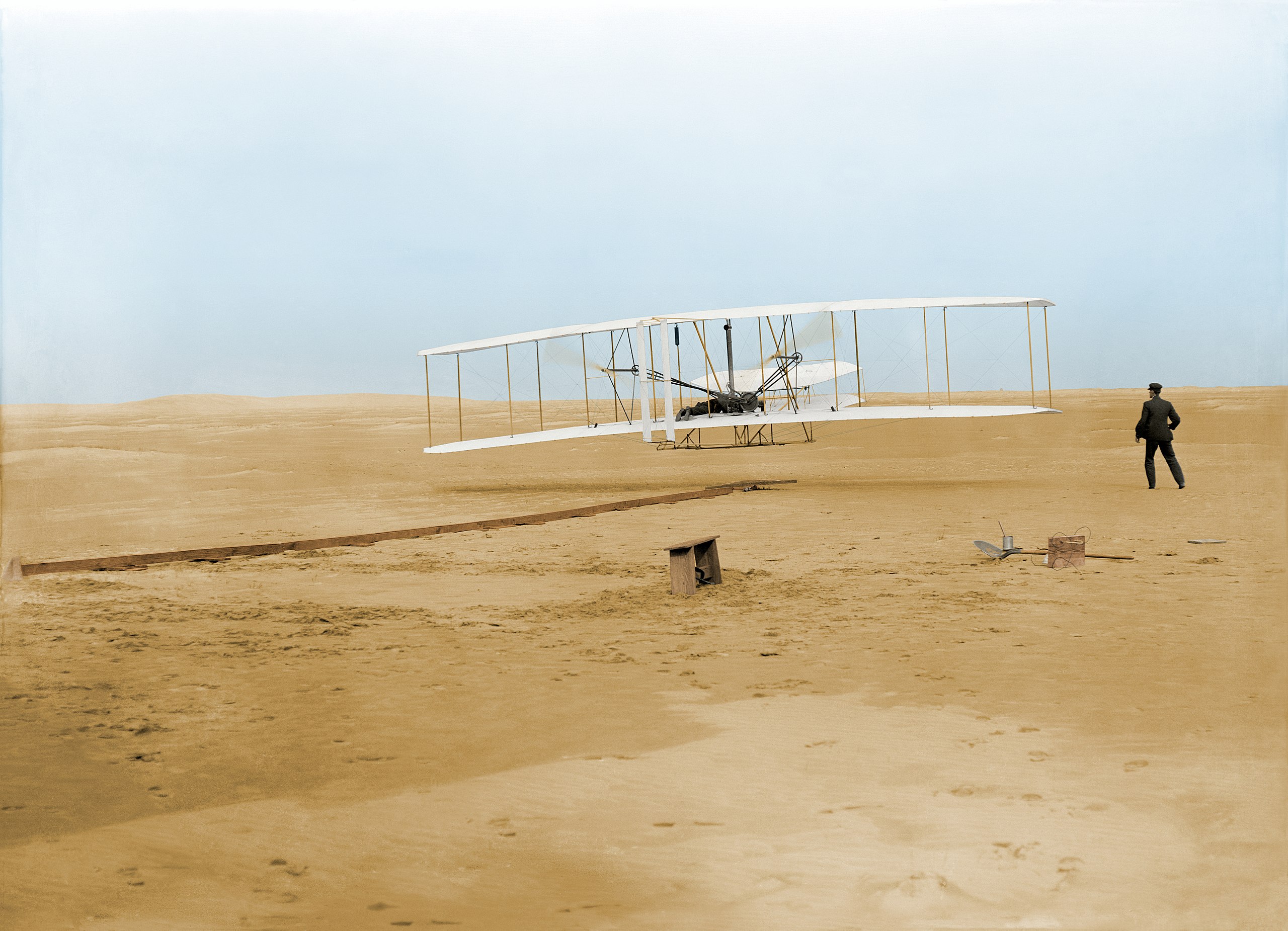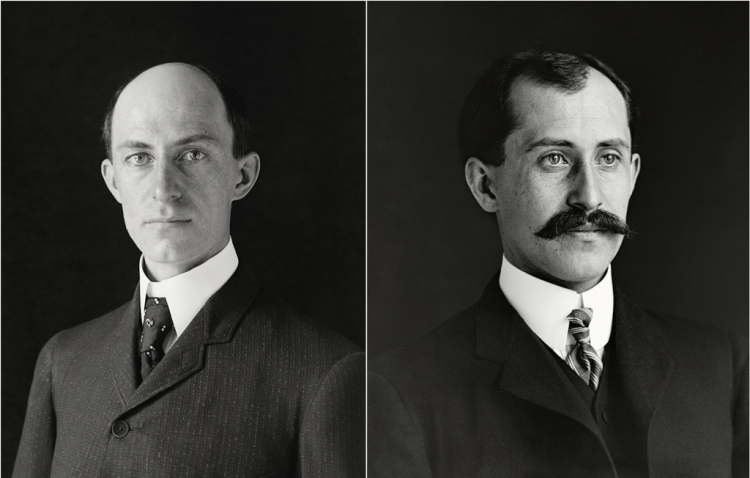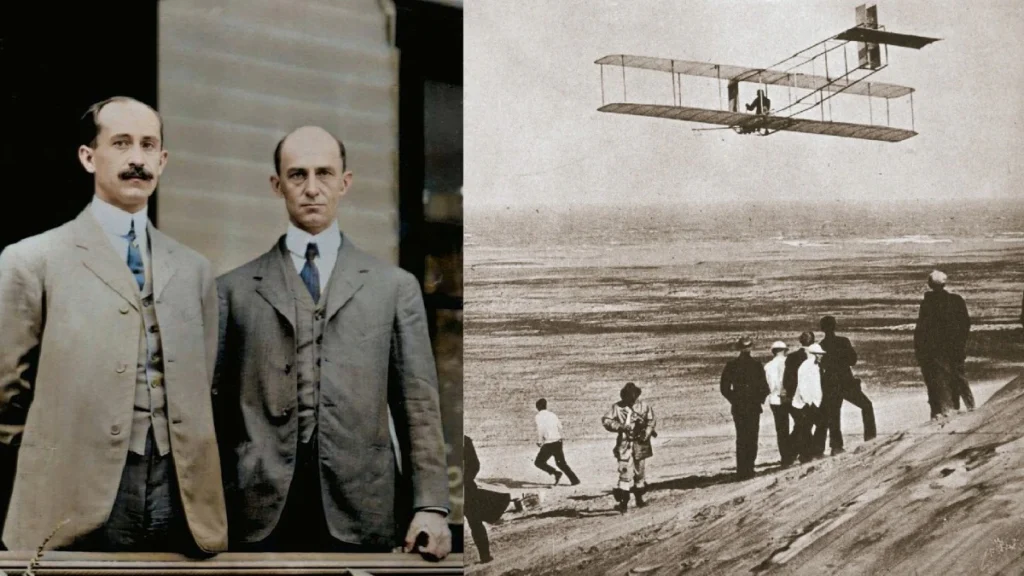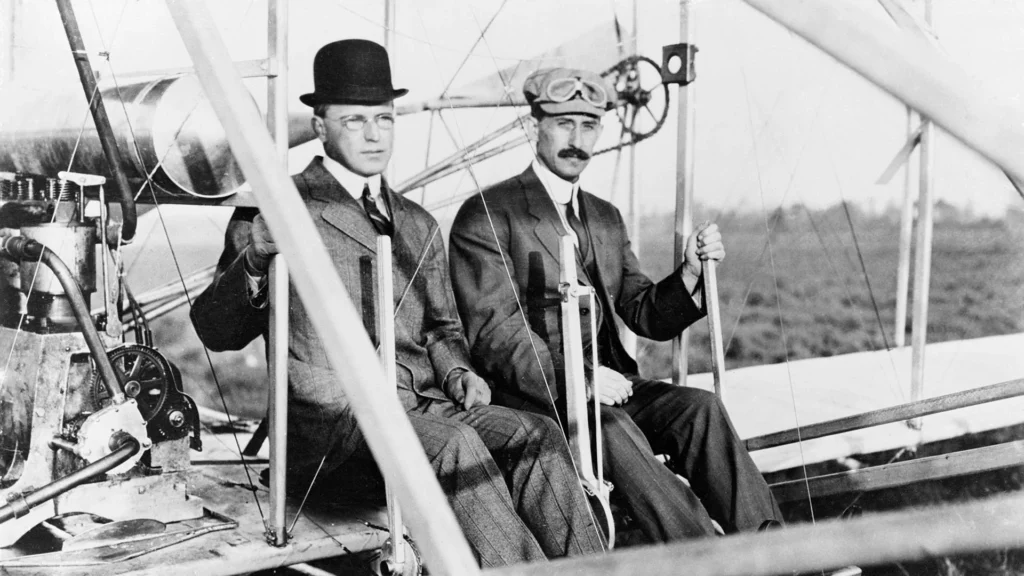“Framing the Future: The Story Behind the Wright Brothers’ Flight Photo”

On a cold December morning in 1903, on the windswept dunes of Kill Devil Hills near Kitty Hawk, North Carolina, a single black-and-white photograph froze in time one of humanity’s most transformative achievements: the first powered, controlled, and sustained flight by a heavier-than-air machine.
The image, now iconic, shows a fragile craft just lifting off the sand. Lying prone at the controls is Orville Wright, while his brother Wilbur runs alongside. This grainy image didn’t just capture a historic event—it symbolized the dawn of the aviation age and reshaped human mobility forever.

📸 The Photograph: A Frame of Firsts
The famous photo was taken at 10:35 a.m. on December 17, 1903, using a Gundlach Korona V view camera mounted on a wooden tripod. The camera was triggered by John T. Daniels, a member of the local U.S. Life-Saving Service, who had never used a camera before.
Daniels captured the first successful flight of the Wright Flyer, as it lifted 12 seconds into the air, traveling 120 feet. The photo shows:
- Orville Wright lying flat on the lower wing, operating the controls
- Wilbur Wright running beside the aircraft to help balance it
- The flyer just inches off the ground, mid-takeoff
Despite its modest appearance, this image became a defining visual of the modern era.
🛠️ The Wright Brothers’ Journey to Flight
Early Curiosity:
Wilbur and Orville Wright, bicycle makers from Dayton, Ohio, were largely self-taught engineers. Inspired by the flight of birds and the work of pioneers like Otto Lilienthal and Octave Chanute, they began experimenting with gliders in 1899.
Key Innovations:
- Three-axis control system: pitch (elevator), roll (wing-warping), yaw (rudder)
- Custom-built wind tunnel: to test airfoil shapes
- Propeller design: carved by hand and scientifically optimized
- Lightweight engine: 12-horsepower internal combustion engine designed with machinist Charles Taylor
By late 1903, they had assembled a 605-pound flying machine—the Wright Flyer I—made of spruce wood, muslin fabric, and bicycle parts.
🌬️ Why Kitty Hawk?
The Wrights chose Kitty Hawk, North Carolina for several strategic reasons:
- Steady, strong winds (ideal for liftoff)
- Soft, sandy terrain for crash landings
- Relative isolation for secrecy and safety
They made multiple test flights and assembled the flyer in a wooden hangar near the dunes.
✈️ December 17, 1903: The Four Flights
That historic day, the Wright brothers made four flights:
- First flight:
- Pilot: Orville
- Duration: 12 seconds
- Distance: 120 feet
- Second flight:
- Pilot: Wilbur
- Duration: 12 seconds
- Distance: 175 feet
- Third flight:
- Duration: 15 seconds
- Distance: 200 feet
- Fourth flight:
- Duration: 59 seconds
- Distance: 852 feet
- Damaged on landing due to a strong gust
The final flight ended in a minor crash that broke the aircraft’s frame, but the mission was complete: humans had flown.
🧑🔬 John T. Daniels: The Accidental Photographer
John T. Daniels, the man who clicked the shutter, was a surfman with the Kill Devil Hills Life-Saving Station. He had no photography experience but was entrusted with the camera while the Wrights focused on flying.
When the plane took off, Daniels instinctively pressed the bulb shutter at just the right moment. That single act captured the most famous aviation photograph ever taken.
Daniels later joked he was also part of the “first airplane crash” because he tried to stop the damaged plane during its final landing and got tangled in it.

🌍 After the Flight: From Obscurity to Aviation Legends
Despite the breakthrough, the world did not immediately take notice. Early press accounts were dismissive or inaccurate. The Wright brothers returned to Dayton, continued testing, and perfected their designs over the next few years.
By 1908, they were demonstrating aircraft in Europe and the U.S., gaining acclaim and securing military contracts. The photograph helped support their claims of prior invention, especially during patent disputes.
🎞️ Legacy of the Photo
The photo is often called “The Birth Certificate of Flight.” Today, it is preserved in the U.S. Library of Congress and reproduced in countless books, documentaries, and museums.
What makes it iconic:
- The timing: capturing a machine defying gravity for the first time
- The framing: Wilbur, mid-run, evokes motion and human achievement
- The simplicity: no crowds, no fanfare—just sand, sky, and history
It is a visual shorthand for innovation, daring, and the spirit of progress.
✈️ The Wright Flyer: Where Is It Now?
- The original Wright Flyer I was damaged in 1903 and restored years later.
- It now hangs in the Smithsonian National Air and Space Museum, proudly displayed above the inscription:
“The Original Wright Brothers Airplane—The World’s First Power-Driven, Heavier-Than-Air Machine in Which Man Made Free, Controlled, and Sustained Flight.”

🧠 Conclusion: One Image, Infinite Horizons
The Wright brothers’ first flight marked more than a technological leap—it was the beginning of the modern world. The photograph taken that morning captured not just a plane, but the first crack in the sky, the moment when dreams of flight became reality.
From commercial aviation to space exploration, it all started with a handmade flyer, two brothers, and one perfectly timed click of a shutter.




